San Francisco Whale Watching
Whales are majestic creatures that never fail to fascinate people. In fact, there’s a New York museum with a whale hanging from the ceiling. Walking under the hanging whale gives visitors a sense of its overwhelming presence. Imagine yourself whale watching near San Francisco and seeing the whales in action. Feel the excitement and the exhilaration of seeing whales up close.
Fortunately, there are whale watching cruises in San Francisco. These tours can take you to where the whales are and where the action is.
Table of Contents
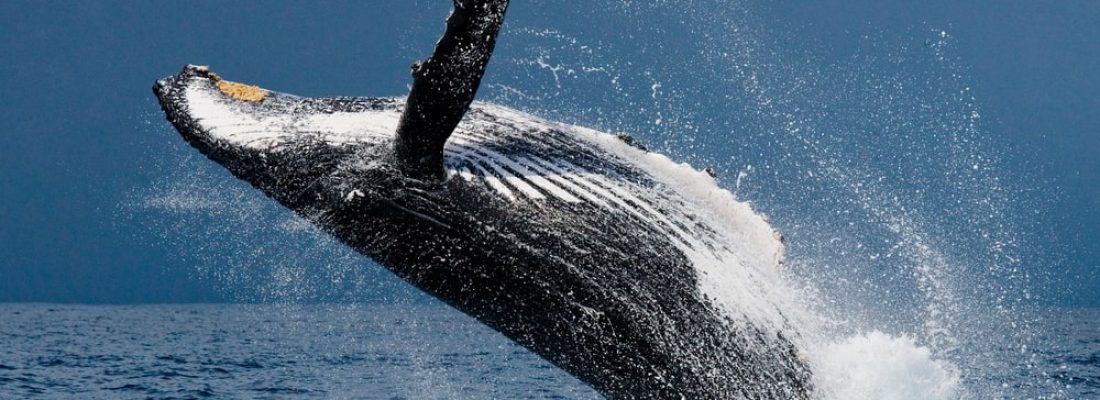
Where Can I See Whales Near San Francisco?
There are several places where you get to enjoy whale watching near San Francisco. Not only can you see whales, you feel closer to nature. To get the most out of whale watching, certain places offer a better view than others. Consider the following:
Bodega Head
Each year, thousands of migrating whales pass through the Bay Area. Many regard Bodega Head as a significant navigational landmark for the whales. The west of Bodega Bay’s granite headland is one of the best spots. Here you can see the female whales or cows and their newborn calves.
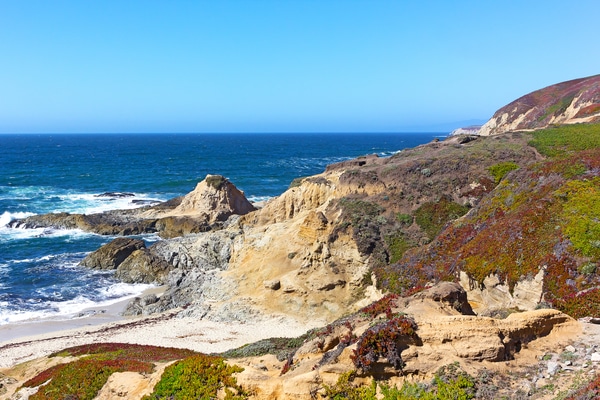
Fort Funston
San Francisco’s Pacific Coast side is where you will find Fort Funston. It is San Francisco’s Pacific Coast’s southernmost beach. It is also one of the Golden Gate National Recreation Areas. Fort Funston is famous for its hang-glider platform and windy conditions. The bluffs offer a lot of opportunities for whale watching within the city limits.
Point Reyes National Seashore
Whale aficionados find that Point Reyes National Seashore is a good spot to watch whales. The Point Reyes observation deck and historic lighthouse is regarded the best spot. Located on the westernmost part it is an ideal spot to see whales passing through the waters of the Bay Area.
Only a limited number of visitors are allowed on the viewing platform at a time. Fortunately, those who are in a queue to access the viewing platform can still gain a nice view of the Pacific. 94% 0f migrating gray whales pass within one mile of the protected peninsula. This makes whale watching near San Francisco such a popular activity.
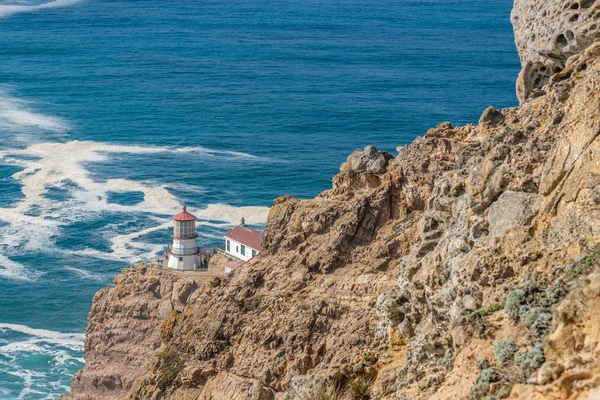
Point Bonita
Point Bonita, is a well-known whale sighting site. You can view the whale-filled waters at Marin Headlands’ southernmost point. Even though Point Bonita may still be closed due to the pandemic. Visitors who want to see the whales in action may try the Bird Island Overlook lighthouse.
Muir Beach Overlook
If you want a location with spectacular views of the Pacific Ocean, try Muir Beach Overlook. It can be found off Highway 1 in Marin Headlands. Whale watchers who are uncomfortable with the cliff-side overlook may try the paved trail. Anyone can access this easily. The trail is just above Muir Beach.
Lands End Lookout
Lands End Lookout offers scenic views of the Golden Gate Bridge and Marin Headlands. And it is an ideal vantage point to view migrating whales. The seascape view is a sight for sore eyes, especially when you begin to see the whales. It is wise to always carry a set of binoculars when you plan to trek the winding trails or whenever you go out. You never know when you will get a sudden itch to go whale watching near San Francisco.
Devil’s Slide Trail
The Devil’s Slide Trail is a paved, well-marked trail that can be accessed easily. Even by someone with a bicycle, stroller, or motorized scooter. The sides of the Devil’s Slide Tunnel have parking lots for added convenience. The Devil’s Slide Trail once had a reputation for having a treacherous stretch. The former Highway 1 segment was prone to rock slides. Today, it is a part of the California Coast Trail.
Gulf of Farallones
Waiting for whales to come under the Golden Gate Bridge can be frustrating at times. Instead of waiting for the whales to pass by, why not go whale watching near San Francisco? To be precise, why don’t you visit the Gulf of the Farallones by boat? The Gulf of Farallones is a marine sanctuary that is 3,295 square miles wide.
The area offers feeding and breeding grounds for at least 25 threatened or endangered species. These include a variety of seals, humpback whales, gray whales, blue whales, sea lions, and Pacific white-sided dolphins. Aside from whales, you will see more amazing sights when you visit the place. Whale watching cruises in San Francisco can take you to the Gulf of Farallones.
What Types of Whales Can I See Near San Francisco?
Here are the common types of whales to see in San Francisco and nearby areas.
Gray Whales
The Gray Whale is also known by other names – gray back and devilfish. A Gray Whale has short baleen, which the baleen whales have inside their mouths as their filter-feeding system. The baleen whales have 14 species that include Gray, Minke, Humpback, Right, Fin, and Blue Whales. Baleen whales are generally larger than whales with teeth, except for the Sperm Whale.
Gray Whales have short baleen, no dorsal fin, and a smaller head than most baleen whales. They have 9 to 13 knuckles or bumps from the back midpoint to the tail flukes and are a grayish color. Between the adult male and female, the latter is slightly bigger.
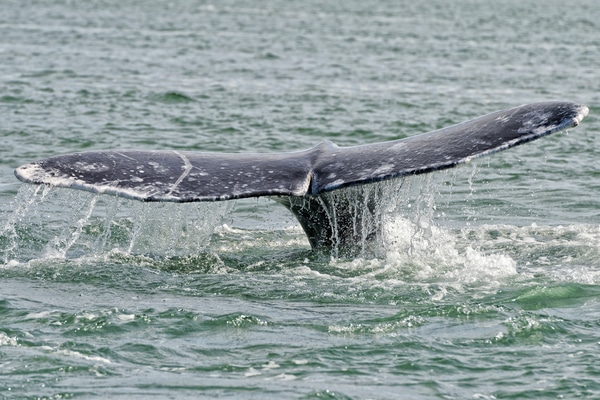
Gray Whales feed on polychaete tubeworms, tube-dwelling amphipods, and mysids. These are found in the northern parts of their reach. They are also known to feed on baitfish, red crabs, megalops, cephalopods. Also eggs and larvae of herring, mobile amphipods, and crab larvae form part of their diet. The lifespan of a Gray Whale is about 40 years.
Most Gray Whales in some locations show curiosity toward boats. Gray whales due to their numbers are the focus of whale watching near San Francisco. They are also a major component of ecotourism along North America’s west coast. Gray Whales travel between 5,000 and 7,000 miles, each way on their annual migration. It is also one of the longest migrations for any mammal.
Blue Whales
Blue Whales are the largest creatures that have ever lived on our planet. They are bigger than the Patagotitan mayorum the largest known titanosuar. Which has an estimated length of 37 meters and weight of around 70 tons. Blue Whales usually grow 34 meters long and weigh up to 200 tons. The Blue Whale’s tongue alone can be as heavy as an elephant.
A Blue Whale has a long, tapered body with broad, triangular flukes at the end. It has a wide, flat head. With a spotty blue-gray color when seen on the surface, but it displays its true blue color underwater. The underbelly of a Blue Whale has a yellowish hue created by the millions of microorganisms that dwell in their skin. The female Blue Whales are slightly bigger than the males.
Blue Whales feed mostly on krill, which are tiny shrimplike creatures. A single adult Blue Whale can eat around 4 tons of krill per day during certain times each year. They have no trouble getting the tiny krill each time they swallow. As they filter their tiny food from the enormous amount of water. It’s all thanks to their baleen plates. These are connected to their upper jaws and made of tasseled plates of finger-like material.
While whale watching, you may chance upon the Blue Whales and other baleen whales feeding. The pleated skin on their belly and throat expands to take in so much water. The massive tongue of a baleen whale pushes the water out through the fine overlapping plates. This filters out the tiny morsels of food. Thousands of tiny food particles will be left behind ready for swallowing. On average, Blue Whales live between 80 and 90 years.
Most things that Blue Whales have are bigger than other species of animals. They have big hearts, colossal bodies, and are longer than most creatures that ever lived on earth. Blue Whales have gigantic tongues, and make the loudest sounds from any creature on earth. They feed on tiny krill, and they are pretty fast considering their weight. When cruising they usually go 8kph and can accelerate up to 32kph. Only when circumstances necessitate them to do so.
Orcas
The Orcas or Killer Whales were originally named killer whales. This name was given by the sailors who saw them hunt other whales. Over time, the name was switched around. The species name of Killer Whale in Latin is Orcinus orca. Orcinus means “Kingdom of the Dead”. The whale order or Cetacea has several families. One of them is Delphinidae that includes the species of dolphins. You will get more than you expect when you go whale watching near San Francisco.
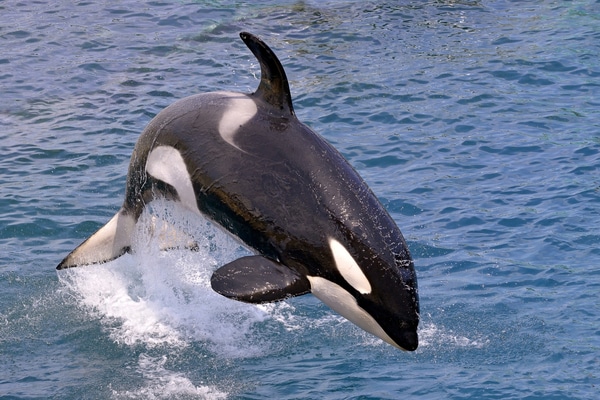
The term Cetacean came from the Greek word ketos, which means whale. The Cetacean order of sea animals includes whales, porpoises, and dolphins. All dolphins are considered whales. However, not all whales belong to the dolphin family. Think of dolphins as smaller whales. Killer Whales are the largest members of the dolphin family.
Killer Whales have cylindrical bodies that look like a silkworm cocoon with tapered ends. The fusiform shape creates less drag when swimming. This is one of the more energy-efficient body shapes. The Orca is one of the toothed whales. The large teeth of the Killer Whales are interlocking and pointed. They only have one set of teeth that will no longer grow back once lost. Orcas have black and white colors, and a gray patch on the back called a cape or saddle. The adult male Orcas are bigger than the adult females.
Killer Whales are on top of the food chain. They prefer to feed on squid, fish, and other meats that toothed whales usually consume. Killer Whales also target sea birds, seals, and even bigger whale species like Minke. Orcas are also known as the sole predators of great white sharks. They use their teeth to take hold of their prey and tear it into small chunks to make it easier to swallow. Orca males usually live between 30 and 60 years, while females can live between 50 and 80 years.
Whale watching near San Francisco can be worthwhile with Orcas around. They belong to the dolphin family so they have a playfulness while swimming together. They live in big pods of family members. The pod leader is a female Orca.
Fin Whales
The Fin Whale, sits in the number two position among the largest whales. These can be found almost anywhere in the world. It has a noticeable fin on the back, close to its tail; hence, its name. Behind its dorsal fin is a well-defined ridge along its back, which earned it the nickname ‘razorback’. It is also known as common rorqual or Finback Whale. Its former names were Razorback Whale and Herring Whale.
Fin Whales have a V-shaped head and a streamlined body. It has a hooked, tall dorsal fin. They have a distinctive coloration and unusual features. Its sides and back have dark brownish-gray or black color, and its underside is white. The lower left jaw is black, and it is white on the lower right jaw. The tail flukes’ underside is white with a border in gray color. Markings are unique to each Fin Whale and can be used to identify each of them. Female Fin Whales are just slightly bigger than their male counterparts. The difference in size is hardly noticeable. You can try spotting them when you go whale watching near San Francisco.
Fin Whales can swim fast. They can be found in groups of two to seven whales. Fin whales usually feed on squid, sand lance, capelin, herring, and krill. They can filter their tiny food effectively with the help of their baleen plates. Fin Whales usually consume a maximum of 2 tons of food each day. They can live for about 80 to 90 years.
Due to excessive whaling between the 19th and 20th centuries, most species of whales declined in numbers. The Fin Whales have recovered a lot better than the other species of whales. They are hard to catch due to their speed. The chances of seeing a group of Fin Whales are about 10 times higher than meeting other species of whales. Their behavior is similar to that of Blue Whales, and they are also almost as big.
Minke Whales
The scientific name of Minke Whales, Balaenoptera acutorostrata, translates to “winged whale” and “sharp snout” respectively. The Minke Whales got their name from a person named Meincke, a Norwegian whaling spotter. He thought he spotted a Blue Whale when it was a Minke Whale that he saw.
Minke Whales have dark gray, brown or black coloring on their backs. The underside of the flippers of a Minke Whale has lighter color. It is the same with its belly. You will notice a diagonal white band on each flipper. Some Minke Whales’ backs have a light chevron on them. The color of the underside of the tail flukes may be white, blue-gray, or pale gray. The baleen plates come in cream, gray, or white color. Female Minke Whales are a bit bigger than the males. You will likely encounter more of them when you go whale watching near San Francisco.
Minke Whales feed on what is most abundant in the area they are currently in. The usual food sources of Minke Whales include small schooling fish and krill. However, you may find them feeding occasionally on big fish, such as haddock and mature arctic cod. Some of them feed on sand eel, copepods, and krill. They also feed on cod, mackerel, capelin, and salmon in the North Atlantic. Minke Whales live between 40 and 50 years.
Minke Whales are known for their inquisitiveness, and most of them don’t shy away from boats. You will likely view Minke Whales at close range more than the other baleen whales.
Humpback Whales
Humpback Whales are well known for their haunting, evocative songs or calls. The byzantine sequences of cries, howls, and moans of Humpbacks can travel far and wide. The songs can go on for hours. The specific function of the songs that Humpbacks produce remains unknown. However, there are many theories about it.
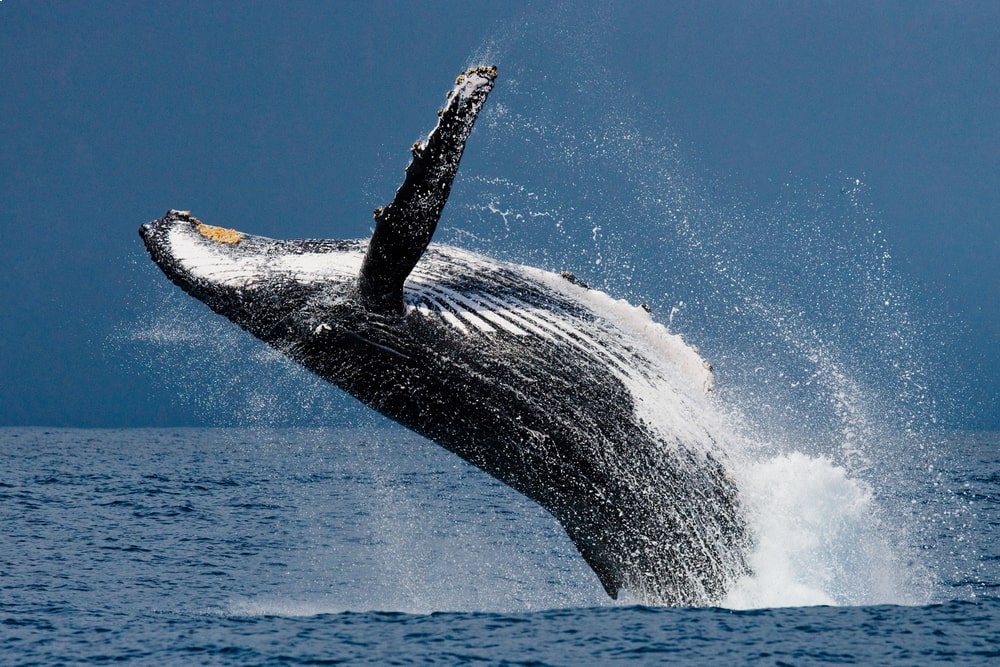
Male Humpbacks produce long songs, while the vocalizations that females make are shorter. Male Humpbacks usually produce such songs during mating season. It is speculated that they do that to attract females. It is also their way of challenging the other males. Another theory is that it acts as sonar, which helps the Humpback Whales navigate their way. They also snort, groan, and grunt to communicate with other Humpback Whales.
Even calves use low tones to whisper to their mothers and communicate. However, you may never see it often even if you regularly go whale watching near San Francisco.
The Humpback’s dorsal fin appears as a bump or hump. The hump is more noticeable each time they rise from the water and bend their backs to dive. They got their name from that hump on their backs. The Humpback Whales are primarily black. Some of them have white markings on the underside of their tails, bellies, and pectoral fins. The adult female Humpback Whales are slightly bigger than the male Humpbacks.
Humpback Whales usually feed on small invertebrates, small crustaceans, and krill. They also feed on mackerel, sardines, anchovies, and other small schools of fish. As a member of the baleen whale family, Humpbacks have no trouble filtering the tiny food.
They also use a method known as bubble netting to trap the fish. They usually do it by diving into a school of fish and spiraling back to the surface while blowing air bubbles. The idea is to create confusion or distraction to trap the fish. The whales will then scoop and gulp down the trapped fish. This method is often carried out in groups. However, not all groups know how to use the bubble netting method. Humpback Whales have a lifespan between 80 and 90 years.
Humpback Whales have non-aggressive, gentle nature. It is very unlikely for them to inflict harm to humans. However, they are curious to the point that they don’t shy away from the boats. This makes whale watching near San Francisco more worth it. There are whale watching cruises in San Francisco that can take you near the whales.
Humpback whales tend to do some acrobatics, they sometimes breach and have hit boats. Breaching happens when a whale lifts its colossal body above the water and exposes 90% of its flesh. When it begins to land, it may fall on its back or side and create a gigantic splash. Imagine the spectacular view when you see it up close, but brace yourself and be ready to get wet.
Humpback Whales are many people’s favorite due to their exhilarating show.
Sperm Whales
The head of the cachalot or Sperm Whale is filled with spermaceti, which means whale seed in Latin. Scientists believe that spermaceti may help regulate the whale’s buoyancy. Whalers once thought that the oily fluid in the head of a Sperm Whale was sperm. Scientists are still not clear about the exact function of the mysterious substance.
There’s a common theory that spermaceti turns into a hardened wax when it is cold. This then enables the whale to modify its buoyancy. When that happens, the Sperm Whales can do a deep dive and rise without trouble. These gigantic mammals can hold their breaths for an hour and a half each time they do a deep dive. The spermaceti was once used as fuel for lamps and fine lubrication.
Among the toothed whales, the Sperm Whales are the largest. They also have the largest brain among the creatures that ever lived. A whale watching tour will be truly satisfying when you see some Sperm Whales.
Sperm Whales are generally gray-colored with prune-like, wrinkled skin covering their submarine-shaped bodies. The huge square head of a Sperm Whale covers a third of its entire body. It has rudimentary upper teeth, which may not be visible. Its lower jaw holds 20 to 26 banana-shaped or conical teeth and each tooth weighs around 32 ounces or two pounds. Adult male Sperm Whales are bigger than their female counterpart.
To hunt for food, Sperm Whales usually take deep dives. The routine dives can last for 45 minutes and up to 2,000 feet deep. Sperm Whales are also capable of reaching depths of over 10,000. The Sperm Whales rise to the surface to breathe after having long, deep dives. They need time to recover that usually takes minutes before going in for another dive.
Sperm Whales feed on skates, sharks, squid, octopuses, and fish that dwell in the deep parts of the ocean. They also eat colossal squids. You may want to take note that a Sperm Whale consumes about a ton of food or around 3% to 3.5% of its body weight in a single day. It can sometimes consume up to two tons of food in a day. Sperm Whales have an average lifespan of 60 years.
The novel Moby Dick made Sperm Whales quite famous. It was based on a tragic event during the time when whaling was still rampant. Sperm Whales were one of the most popular targets of whalers. Whaling is illegal in majority of countries today. Sperm Whales are relatively docile.
Migration Times and Patterns of the Major Whales I Can See Near San Francisco
Targeting a particular species of whale to watch? You will need to know their migration times and patterns. This will then allow you to get the most out of your whale watching.
When to Spot Gray Whales
Migration begins between mid and late September. Gray Whales travel day and night at approximately 120 kilometers per day. Between mid and late December, many Gray Whales may be found between Monterey and San Diego. You may even view them from the shore as you go whale watching near San Francisco.
Between late December and mid-January, Gray Whales begin to arrive at Baja’s calving lagoons. The earliest ones are usually pregnant cows. They come seeking the protection of the lagoons for when their calves are born.
Between early and mid-February, the rest of the Gray Whales begin to turn up. The cycle of life for Gray Whales starts anew – giving birth to calves and mating. The lagoons are filled with Gray Whales between mid-February and late March. This is a combination of mating, nursing, and calving whales. Normally, the first Gray Whales to embark on a new journey are the males. After mating, they need to go back north and visit their feeding grounds for the summer.
Nursing mothers and pregnant cows are the last to leave. This usually takes place between late March and mid-April. Once the young calves are strong enough and ready to travel. They can stay in the lagoons between May and June when needed. You may want to take note of the said dates when you spend time whale watching near San Francisco.
You may also want to take note of the following:
October to February
The Gray Whales travel southbound to Mexico coming from Alaska. They can be seen swimming offshore, along the entire coast.
February to April
The Gray Whales travel northbound to Alaska coming from Mexico. Mothers are traveling with their calves and tend to stay close to the shore as they move slowly. It is during such times when you get to see the mothers and their calves together.
When to Spot Blue Whales
You can find Blue Whales in all oceans but the Arctic. They migrate between summer for their feeding grounds and winter when breeding happens. However, some evidence implies that Blue Whales in certain areas do not migrate at all.
Blue Whales prefer to follow the route or stay in a place where krill, their primary food source, is abundant. Their range expands to the Greenland Sea. There are sightings of Blue Whales off the eastern United States and off eastern Canada. They likely go off the U.S. West Coast during summer to feed.
You can find the Blue Whales in Monterey Bay feeding on krill between June and October. The best time to go whale watching near San Francisco is between July and October. Mothers and young calves can be seen from December to March in the Gulf of California.
In November, Blue Whales begin to migrate south. It is still not clear as to where they gather together to mate and give birth. There has been suspicion that it happens in the south of Mexico.
When to Spot Orcas
The Killer Whales thrive in all oceans of the world – from the tropics to the Antarctic. Unlike most whales, Orcas do not follow a specific annual migration pattern. They tend to go where they can get access to their food source. The seasonal migrations of herring and salmon influence the migration of some Orcas. They move according to the movements of their favorite prey. Orcas that prefer to feast on sea lions and seals will likely follow the route that their prey has taken.
In Northern California, the most ideal time to spot Killer Whales is between December and May. However, you may spot them occasionally in the Monterey Bay area. They usually go there in pods of around 8 to 20 whales between 2 and 5 times each month. Killer Whales are seen most frequently in the Bay between January and May. And then again between September and November.
Some Orcas travel from Southern California to Santa Cruz between April and June.
When to Spot Fin Whales
You can find Fin Whales in all oceans. When the time for mating and calving arrives, head to subtropical waters. They take a journey to these waters when the winter months start. During the summer months, Fin Whales usually go to colder areas of the Antarctic and the Arctic.
During summer and fall, Fin Whales are sometimes seen in Monterey Bay. And in the surrounding areas. The ideal times to view Fin whales are between January and February. And then again from mid-October to December. Fin Whales are usually sighted in the winter near the San Francisco area.
When to Spot Minke Whales
Minke Whales are deemed both cosmopolitan and cultured. They can be spotted roaming the temperate, polar, and tropical waters. Minke Whales that roam along the United States’ west coast area are residents of the area. They already established their home in the waters of Washington, Oregon, and California. The Minke Whales within the area of Alaska are the ones that participate in the annual migration. The primary reasons for their migration are their feeding and mating habits.
It is possible to see Minke Whales all year round in the Monterey Bay area. They can be spotted most frequently during fall and summer. Some resident Minke Whales can be found feeding along the Big Sur Coast and in Monterey Bay’s southern part. They are singles. You can also spot Minke Whales in Southern California from July to October.
When to Spot Humpback Whales
The Humpback Whale is one of the endangered species of whales. Humpbacks in central California migrate to areas near Mexico for mating and calving. They go to areas around coastal California for their fall and summer feeding.
Humpback Whales can be seen when you go whale watching near San Francisco. Particularly, between late April and early December in Monterey Bay. Monterey Bay is the perfect place for the Humpbacks to feed on krill, sardines, and anchovies. They may shift to different feeding spots, depending on the density of their prey.
Among the species of whales in the baleen family, Humpbacks are the most animated. They are often observed deep diving to catch prey from the depth of hundreds of feet. They are also found on the surface where they can be seen lunge feeding. You often see them lob their tail, slap their pectoral fins, spy hop, or breach. You will never get tired of looking at them or may even anticipate their next move.
In Northern California, the best time to see Humpbacks is between May and November. From April to early November, you can find Humpbacks along the central California coast.
When to Spot Sperm Whales
The migration of Sperm Whales is not well understood. Nor is it as predictable as the migration of other baleen whales. Some Sperm Whale populations seem to take different migration patterns. These appear to be based on their age and sex. Adult male Sperm Whales have long oceanographic migrations to reach the temperate waters. The cows usually stay in tropical waters together with their calves.
The best time to go whale watching near San Francisco is between December and May. During fall and summer, whale watchers may visit the Farallon Islands. This is where Sperm Whales, Killer Whales, Blue Whales, and Humpbacks usually feed.
Best Time of Year for Whale Watching
The best time of year to go whale watching in San Francisco and nearby areas is between December and May. During such times, you gain the best opportunity to view more than one species of whale.
Whales often visit the San Francisco area all year round. The only thing that changes when the season turns is the kind of whales that you will encounter.
San Francisco has a warm northern California climate. Expect companies to offer whale watching cruises in San Francisco any time of the year.
Between December and May, you may chance upon Orcas, Sperm Whales, and Gray Whales. You can still view different species of whales in other months. However, the best time to go whale watching near San Francisco is between December and May. During such months, you will likely get to see one or more types of whales. However, you still get a chance to see particular species of whales in different months. You may choose to go whale watching any month. But, try to avoid doing it between mid-November and mid-December.
During the mentioned time frame, the particular species of whales are on the tail end of migration. Because of this, you won’t be able to see the number of whales that you expect. Your whale watching activity near San Francisco won’t be as enjoyable as the other months. To get the most out of whale watching in San Francisco, take note and remember the time frame to avoid.
Best Whale Watching Cruises from San Francisco
Here are some of the best watching cruises from San Francisco that you may try:
San Francisco Whale Tours
Phone: 415-706-7364
If you want to experience a different kind of adventure from San Francisco. Go to Farallon Islands’ protected sanctuary, with San Francisco Whale Tours. It will be one of your most unforgettable trips. Experience views of the Golden Gate Bridge to see Gray Whales and Humpbacks. You may also chance upon more than one species of whales.
Oceanic Society Whale Watching
Phone: 415-256-9941
Oceanic Society helps thousands of people witness the Bay Area’s amazing marine wildlife. This includes seabirds, dolphins, various species of whales, and more. The Oceanic Society is an advocate of marine conservation. They use their trips to gather data for their marine research. They also support the efforts of locals to uphold marine conservation. You will gain valuable nature experiences via their educational nature trips.
Angel Island-Tiburon Ferry
Phone: 415-435-2131
This company provides ferry service between Tiburon and Angel Island State Park. They offer Whale Watching Cruises, Golden Gate & Alcatraz Bay Cruises, and Sunset Cruises. Special Event Cruises like New Year’s Eve or Fleet Week, and private charters can also be arranged. You can try one or try them all.
Silver Fox Sport Fishing and Tours
Phone: 800-349-5775
If you are looking for a premier charter and sportfishing boat in San Francisco, you should try the Silver Fox Sport Fishing and Tours. You can find it at San Francisco’s Fisherman’s Wharf Slip #2. The sportfishing and tours business has been a family business for generations. The company offers a host of activities. Such as burials at sea, corporate parties on water, a great white shark tour, and sport fishing. Including, San Francisco Bay tours where you can get a chance to encounter several whales.
Best Places to View Whales from the Shore
If you don’t want to take boats to go whale watching, the best places to see the whales from the shore are:
- Muir Beach overlook
- Point Bonita
- Point Reyes National Seashore
- Fort Funston
- Lands End Lookout
- Golden Gate National Parks
If you want to see the whales, raptors, or hawks migration up close, you can go to the Golden Gate National Parks. - Pigeon Point Lighthouse
This lighthouse was built in 1871 and has remained the tallest lighthouse in the area. It provides a great view of the visiting whales.
If you want to view whales from land, you may also try the areas along the coast.
Whale Watching From the Shore Around San Francisco
- Point Montara Lighthouse
This lighthouse is perched on a bluff where you can have an unobstructed view of the Pacific. From there, you can see the whales breach, spy-hop, and blow water. - Salt Point
Sonoma coast presents one of the most scenic spots – the Salt Point. It has walking trails that provide views of scenic spots and the Pacific Ocean. You can get a lot of opportunities to go whale watching near San Francisco. - Fort Ross
Just below the fort lies a protected beach, the Sandy Cove, where you can take a stroll and may even see some whales. - Año Nuevo State Park
This park is famous for providing a safe haven for more than 10,000 elephant seals. These keep returning to the place every year to molt, give birth, and breed. You may trek along the ocean bluffs of the park to go whale watching.
Can I See Whales in San Francisco Bay?
You may see some whales in San Francisco Bay, and it is still considered a normal sight. Many people find it delightful to see the whales putting on a show. But marine biologists think otherwise. The scientists believe that it could mean trouble when so many whales gather in San Francisco Bay.
The marine biologists fear that the whales are starving and cannot complete the entire trip to Alaska. The whales are using the bay to forage for food and sustain them for their long voyage. Scientists observed that the whales looked smaller than their usual size. They also discovered the bodies of two dead whales, and noted that they had less body fat and blubber than normal.
When they opened the whales’ stomachs, they discovered that the whales have eaten less than usual. Scientists are trying their best to uncover the mystery behind the whales’ lack of food sources as compared to recent years. There’s also a hunch that the whale population is growing and that means less food for all to share.
Final Thoughts
For now, it is good to know that whales are still doing well. Hopefully, there will be more available food for them to consume as they make their great migrations. Whale watching may be one of the most exhilarating experiences of your life. For a more satisfying adventure, try one of the whale watching cruises in San Francisco.